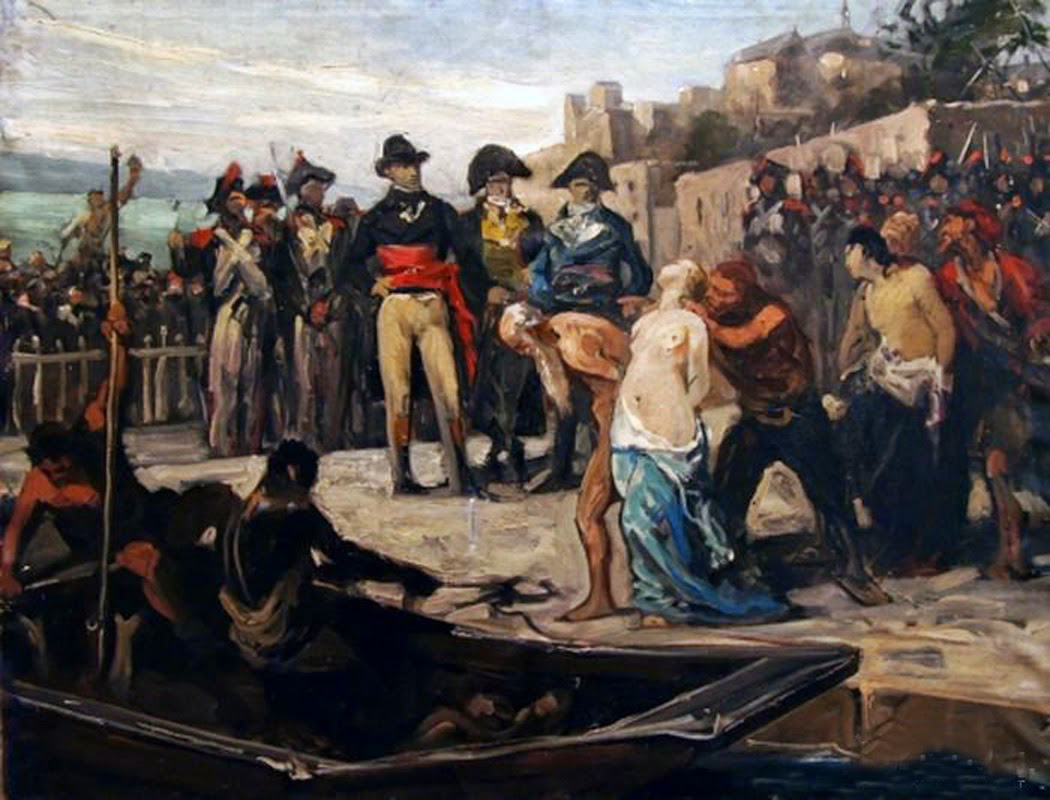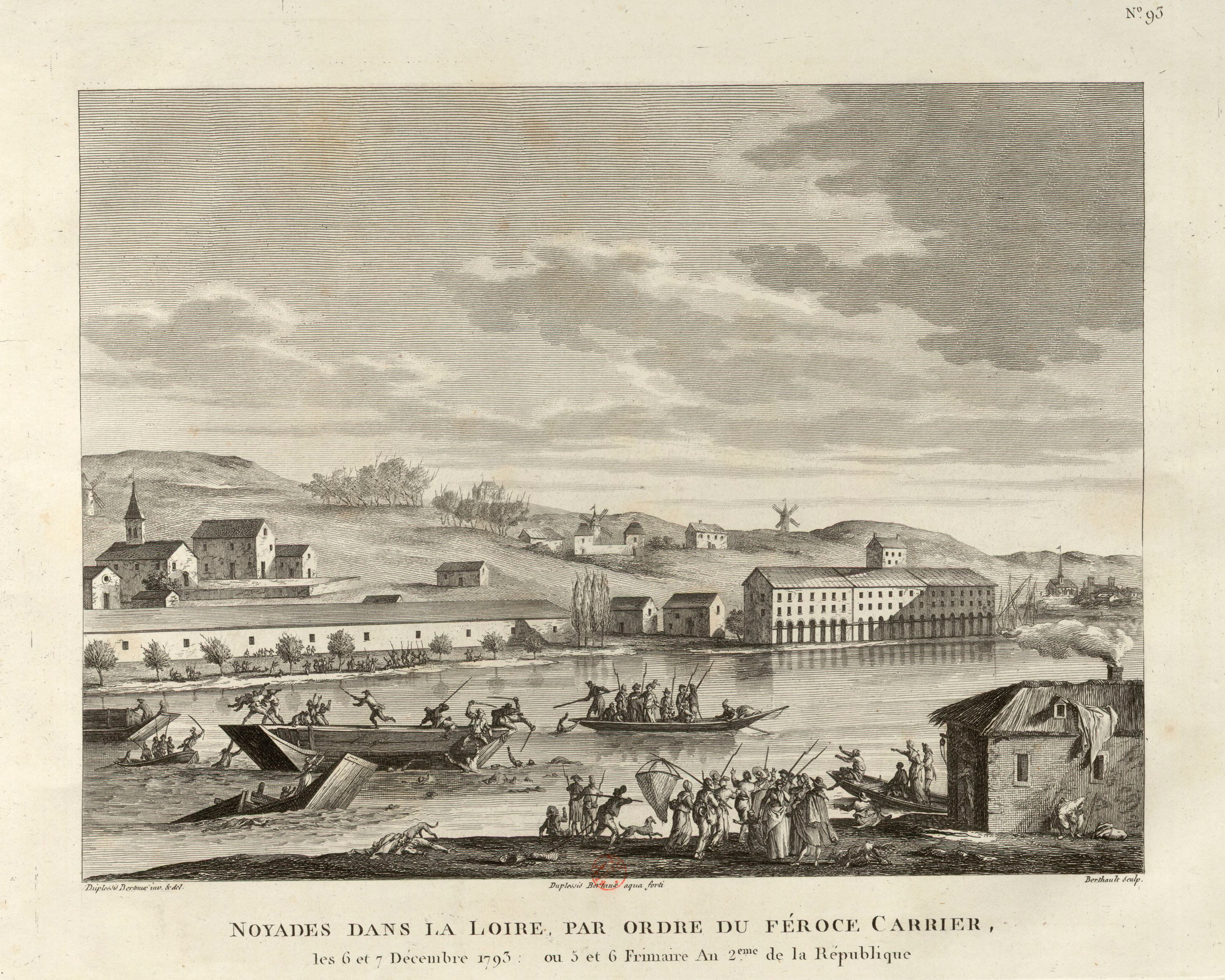|
Drownings At Nantes
The drownings at Nantes (french: noyades de Nantes) were a series of mass executions by drowning during the Reign of Terror in Nantes, France, that occurred between November 1793 and February 1794. During this period, anyone arrested and jailed for not consistently supporting the Revolution, or suspected of being a royalist sympathizer, especially Catholic priests and nuns, was cast into the river Loire and drowned on the orders of Jean-Baptiste Carrier, the representative-on-mission in Nantes. Before the drownings ceased, as many as four thousand or more people, including innocent families with women and children, died in what Carrier himself called "the national bathtub". Background Catholic clergy and émigrés had been victims of angry pro-republican violence and forced deportations by ''sans-culottes'' since the Decree of 17 November 1791 went into force. However, it was the Law of Suspects (french: Loi des suspects) approved by the National Convention of the French First R ... [...More Info...] [...Related Items...] OR: [Wikipedia] [Google] [Baidu] |
Noyades Nantes
The drownings at Nantes (french: noyades de Nantes) were a series of mass executions by drowning during the Reign of Terror in Nantes, France, that occurred between November 1793 and February 1794. During this period, anyone arrested and jailed for not consistently supporting the Revolution, or suspected of being a royalist sympathizer, especially Catholic priests and nuns, was cast into the river Loire and drowned on the orders of Jean-Baptiste Carrier, the representative-on-mission in Nantes. Before the drownings ceased, as many as four thousand or more people, including innocent families with women and children, died in what Carrier himself called "the national bathtub". Background Catholic clergy and émigrés had been victims of angry pro-republican violence and forced deportations by ''sans-culottes'' since the Decree of 17 November 1791 went into force. However, it was the Law of Suspects (french: Loi des suspects) approved by the National Convention of the French First R ... [...More Info...] [...Related Items...] OR: [Wikipedia] [Google] [Baidu] |
War In The Vendée
The war in the Vendée (french: link=no, Guerre de Vendée) was a counter-revolution from 1793 to 1796 in the Vendée region of France during the French Revolution. The Vendée is a coastal region, located immediately south of the river Loire in Western France. Initially, the revolt was similar to the 14th-century Jacquerie peasant uprising, but the Vendée quickly became counter-revolutionary and Royalist. The revolt headed by the newly-formed Catholic and Royal Army was comparable to the Chouannerie, which took place in the area north of the Loire. While elsewhere in France the revolts against the were repressed, an insurgent territory, called the by historians, formed south of the Loire-Inférieure (Brittany), south-west of Maine-et-Loire (Anjou), north of Vendée and north-west of Deux-Sèvres ( Poitou). Gradually referred to as the "Vendeans", the insurgents established in April a " Catholic and Royal Army" which won a succession of victories in the spring and summ ... [...More Info...] [...Related Items...] OR: [Wikipedia] [Google] [Baidu] |
Saint-Clément Convent
Saint Clement, St Clement's or variants may refer to: People * Pope Clement I or St Clement of Rome (died c. 98) **St Clement's Day * Clément of Metz (fl. 4th century), first bishop of Metz * Clement of Alexandria (c. 150 – c. 215), Christian theologian and philosopher * Clement of Ireland (born c. 750), active in the Paris Schools * Clement of Ohrid (c. 840–916), scholar, writer and enlightener of the Slavs * Clement Mary Hofbauer (1751–1820), co-founder of the Redemptorists Places Canada * Saint-Clément, Quebec * St. Clement Parish (Ottawa) * Rural Municipality of St. Clements, Manitoba ** St. Clements (electoral district) * St. Clements, Ontario * St. Clement's School, in Toronto, Ontario France * Saint-Clément, Aisne, in the Aisne department * Saint-Clément, Allier, in the Allier department * Saint-Clément, Ardèche, in the Ardèche department * Saint-Clément, former commune of the Calvados department, now part of Osmanville * Saint-Clément, Cantal, in t ... [...More Info...] [...Related Items...] OR: [Wikipedia] [Google] [Baidu] |
Refractory Clergy
During the French Revolution, the National Assembly abolished the traditional structure of the Catholic Church in France and reorganized it as an institution within the structure of the new French government through the Civil Constitution of the Clergy. One of the new requirements placed upon all clergy was the necessity of an oath of loyalty to the State before all foreign influences such as the Pope. This created a schism within the French clergy, with those taking the oath known as , and those refusing the oath known as non-juring clergy or refractory clergy. Background In the centuries preceding the French Revolution, the Church had functioned as an autonomous entity within French borders. It controlled roughly 10% of all French land, levied mandatory tithes upon the populace, and collected revenues from its estates, all of which contributed to the Church's total income which it was not obliged to disclose to the state. Under the ''ancien regime'', France was divided into t ... [...More Info...] [...Related Items...] OR: [Wikipedia] [Google] [Baidu] |
Brumaire
Brumaire () was the second month in the French Republican calendar. The month was named after the French word for fog, ''brume'', fog occurring frequently in France at that time of the year. Brumaire was the second month of the autumn quarter (''mois d'automne''). It started between 22 October and 24 October. It ended between 20 November and 22 November. It follows the Vendémiaire and precedes the Frimaire. In political/historical usage, Brumaire can refer to the coup of 18 Brumaire in the year VIII (9 November 1799), by which General Napoleon Bonaparte overthrew the government of the Directory to replace it with the Consulate, as referenced by Karl Marx in his pamphlet, ''The Eighteenth Brumaire of Louis Bonaparte ''The Eighteenth Brumaire of Louis Napoleon'' (german: italic=yes, Der 18te Brumaire des Louis Napoleon) is an essay written by Karl Marx between December 1851 and March 1852, and originally published in 1852 in ''Die Revolution'', a German m ...'', in which ... [...More Info...] [...Related Items...] OR: [Wikipedia] [Google] [Baidu] |
Contagious Disease
A contagious disease is an infectious disease that is readily spread (that is, communicated) by transmission of a pathogen through contact (direct or indirect) with an infected person. A disease is often known to be contagious before medical science discovers its causative agent. Koch's postulates, which were published at the end of the 19th century, were the standard for the next 100 years or more, especially with diseases caused by bacteria. Microbial pathogenesis attempts to account for diseases caused by a virus. The disease itself can also be called a contagion. Historical meaning Originally, the term referred to a ''contagion'' (a derivative of 'contact') or disease transmissible only by direct physical contact. In the modern-day, the term has sometimes been broadened to encompass ''any'' communicable or infectious disease. Often the word can only be understood in context, where it is used to emphasize very infectious, easily transmitted, or especially severe com ... [...More Info...] [...Related Items...] OR: [Wikipedia] [Google] [Baidu] |
Auvergne (province)
The history of the Auvergne dates back to the early Middle Ages, when it was a historic province in south central France. It was originally the feudal domain of the Counts of Auvergne. History Auvergne was a province of France deriving its name from the ''Arverni'', a Gallic tribe who once occupied the area, well known for its fierce resistance, led by Vercingetorix, to conquest by Julius Caesar and the late Roman Republic. Christianized by Saint Austremoine, Auvergne was quite prosperous during the Roman period. After a short time under the Visigoths, it was conquered by the Franks in 507. During the earlier medieval period, Auvergne was a county within the duchy of Aquitaine and from time to time part of the "Angevin Empire". In 1225, Louis VIII of France granted Poitou and Auvergne to his third son Alfonso.Elizabeth M. Hallam, ''Capetian France: 987–1328'', London: Longman, 1980, p. 248. On Alfonso's death in 1271, Auvergne, along with the County of Toulouse, Poitou ... [...More Info...] [...Related Items...] OR: [Wikipedia] [Google] [Baidu] |
Prisoner Of War
A prisoner of war (POW) is a person who is held captive by a belligerent power during or immediately after an armed conflict. The earliest recorded usage of the phrase "prisoner of war" dates back to 1610. Belligerents hold prisoners of war in custody for a range of legitimate and illegitimate reasons, such as isolating them from the enemy combatants still in the field (releasing and repatriating them in an orderly manner after hostilities), demonstrating military victory, punishing them, prosecuting them for war crimes, exploiting them for their labour, recruiting or even conscripting them as their own combatants, collecting military and political intelligence from them, or indoctrinating them in new political or religious beliefs. Ancient times For most of human history, depending on the culture of the victors, enemy fighters on the losing side in a battle who had surrendered and been taken as prisoners of war could expect to be either slaughtered or enslaved. E ... [...More Info...] [...Related Items...] OR: [Wikipedia] [Google] [Baidu] |


